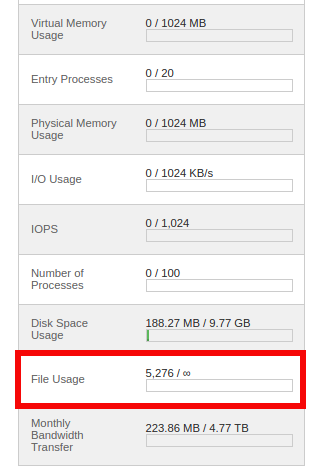An inode is a data structure used to keep information about a file on your hosting account. The number of inodes indicates the number of files and folders you have. This includes everything on your account, emails, files, folders, anything you store on the server.
1 inode = 1 file in your hosting account. Example, one email in your mailbox count as 1 inode too.
What is the Inode Limit ?
For each shared hosting package, we have inode limit as per table given below
Small Business and Lite Packages
| Package | Soft Limit | Hard Limit |
|---|---|---|
| SMBIZ Entree | 40,000 | 50,000 |
| SMBIZ 1 GB | 40,000 | 60,000 |
| SMBIZ 2 GB | 50,000 | 5,000 |
| SMBIZ 4 GB | 75,000 | 100,000 |
| SMBIZ 10 GB | 100,000 | 150,000 |
| Lite 250 / EM 250 | 25,000 | 30,000 |
| Lite 500 / EM 500 | 30,000 | 40,000 |
| Lite 1 GB / EM 1 GB | 40,000 | 50,000 |
| BIZ 1 GB | 100,000 | 150,000 |
|---|---|---|
| BIZ 2 GB | 100,000 | 150,000 |
| BIZ 5 GB | 150,000 | 200,000 |
| BIZ 10 GB | 200,000 | 250,000 |
You will still be able to upload files even if you reach softlimit, but once hard limit threshold is reached file upload will stop working. So you cannot receive new emails or create files on the server.
View Inode usage via cPanel
Just login to your cPanel home page. In the left pane you can see the ‘File Usage’ stat as shown in the screenshot below which is the Inode usage of your account.
Decreasing Inode usage with cPanel hosting
Most people will not need to be familiar with Inodes if they are using their hosting in normal circumstances such as for a basic or intermediate website and normal email use. However, to ensure that all our customers get a consistently high level of service we have implemented inode limits per account for reducing resource abusers in our Shared Hosting and Reseller hosting.
Not all inode overages are caused by abuse though. It could just be that you need to do a bit of a clean up of your hosting files. If you experience issues caused by high Inode usage then this tutorial is to help you decrease the number of inodes on your account.
Here are some steps to reduce the inode number limit.
1) Delete unnecessary files and folders
Examine the files and folders manually and decide on if the file is necessary or not. In case if the file is an old backup archive or if the folder is created for testing or staging purpose, you may remove it or download it locally via FTP or cPanel >> FileManager and delete it from the server.
2) Clear old and Spam Emails
Deleting the old emails helps a lot in decreasing the inode usage. There might be spam mails in your mailbox which are of no use and deleting those mails will hep you to reduce the inode number. You can remove spam emails from email client or webmail. You can seek help from our support department if you wish to empty your complete emailbox.
3) Clear the cache files
Most of the CMSs uses cache to reduce the response time and application like Joomla can create a lot of cache files which can increase the inode usage tremendously. So it is advised to keep an eye on the cache folders and make sure the number of cache files is the least.
Most of the Content Management System now provide the facility to purge the cache and you can make use of it to control the number of cache files. Or you can setup a cronjob to automatically clear the cache files periodically.
If you have the inode limit getting hit regularly or you still have issues after you have cleared up your files, we suggest you to upgrade the package to a higher one with higher inode limit or consider a Virtual Private Server. You can contact our 24/7 support for this.



